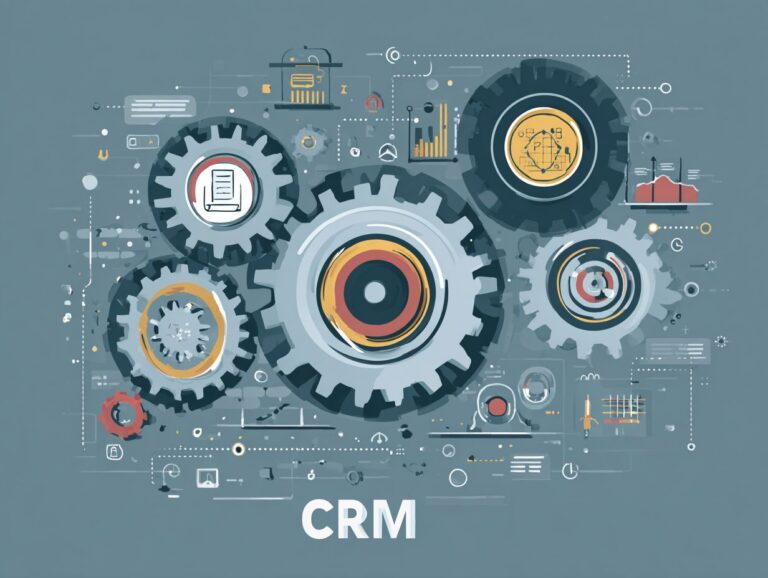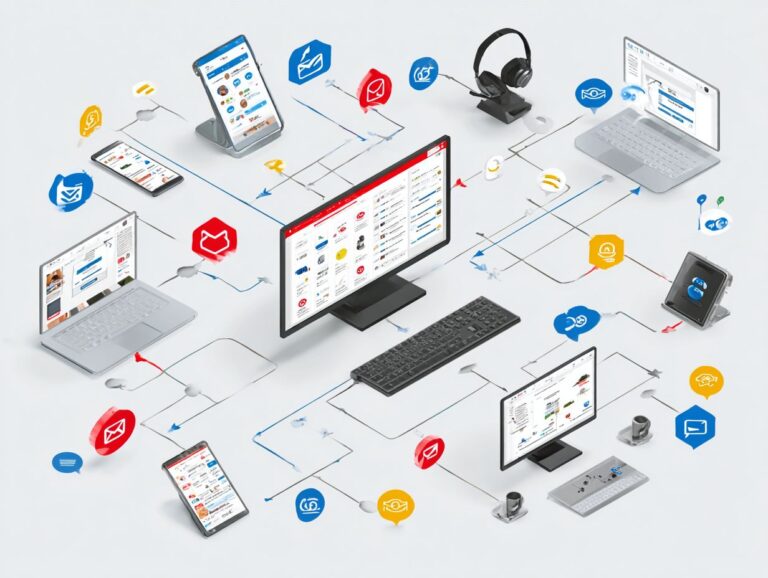How to Integrate CRM Systems? A Complete Guide for Teams
In today’s fast-paced business world, effective CRM integration is essential for creating a single source of truth from your customer data. By linking Salesforce with other external apps, teams can remove data isolation and simplify processes.
In this guide by Missy Roback, you’ll find practical steps to connect CRM systems smoothly, helping your team work well and communicate effectively. Prepare to change how you handle customer interactions!
Key Takeaways:
- Look at what you currently have and figure out what you need to connect before selecting a CRM system. This will help the integration go smoothly.
- Make a clear plan with specific goals and a timeline to successfully combine CRM systems and keep data accurate.
- Continuously gather feedback and provide ongoing training and support to improve CRM integration and maximize its benefits for your team.
- What is CRM Integration?
- Benefits of Integrating CRM Systems
- Assessing Your Current Systems
- Choosing the Right CRM System
- Planning the Integration Process
- Data Migration Strategies
- Testing and Validation
- Training Your Team
- Continuous Improvement and Support
- Frequently Asked Questions
- 1. What is a CRM system and why is it important for teams?
- 2. What are the benefits of integrating CRM systems?
- 3. What are the steps to integrating CRM systems?
- 4. What are the different integration methods available for CRM systems?
- 5. How can teams make sure CRM systems work well together?
- 6. What are some common challenges in integrating CRM systems?
What is CRM Integration?

CRM integration connects various systems, allowing data to transfer between tools such as Salesforce, HubSpot, and Microsoft Dynamics. This integration improves data accuracy by allowing updates to happen immediately on all platforms.
For example, when a sales representative enters a new lead in Salesforce, connecting with marketing tools makes the lead details immediately ready for focused campaigns in HubSpot. Using tools like Zapier can move data between these systems automatically, removing the need for manual data entry.
Setting up APIs from these platforms enables creating workflows designed for particular business requirements (those interested in learning more about enhancing customer interactions can explore our Top-Rated Customer Service Software Examples Revealed). This helps teams work better together, make fewer mistakes, and work together more effectively.
Benefits of Integrating CRM Systems
Using CRM systems can increase sales productivity by 30% by providing quick access to customer details and running marketing campaigns automatically.
To get the most out of a CRM, consider using:
- HubSpot for detailed marketing automation and tracking,
- Salesforce for complex data analysis, and
- Zoho CRM for affordable choices.
Setting up these systems requires teaching your sales team how to use customer information properly. For example, create email campaigns that automatically reply to customer actions; this can raise engagement by more than 60%.
Review customer interactions each week to update your plans, meeting their needs and increasing sales. For a deeper understanding of how technology can enhance customer experiences, consider our comprehensive guide on Customer Experience and Technology.
Assessing Your Current Systems
To effectively connect CRM systems, it’s important to look at your current tools and know what they can and can’t do. Understanding how these systems impact customer satisfaction can be crucial. If you’re curious about how to enhance customer experience through CRM integration, our comprehensive guidelines explain the key strategies.
1. Understanding Existing Tools
- Start by cataloging all existing software applications that interact with customer data, such as project management tools (e.g., Trello, Asana) and communication platforms (e.g., Slack).
- Next, gather customer feedback to pinpoint pain points associated with each application. Use surveys or interviews to ask users about their experiences-focus on difficulties encountered and any desired features.
- Once you have this data, prioritize which tools to integrate by analyzing the most pressing customer needs. For instance, if users frequently mention the lack of seamless file sharing between Slack and Trello, consider integrating these platforms.
- This organized method makes processes more efficient and improves user happiness.
2. Identifying Integration Needs
Look for spots in your current systems where combining elements could improve efficiency, such as reducing separate bits of information and clarifying customer details. Start by mapping out your existing workflows to pinpoint where manual processes create bottlenecks.
For example, if customer information from forms doesn’t update in your CRM, use Zapier to create that link automatically. Create a Zap that starts working each time you have a new entry in your Google Forms. It will move the information to Salesforce without you having to do anything.
Think about connecting communication tools like Slack with project management apps such as Trello to make updates easier. These actions can greatly decrease the time needed for entering data and improve work efficiency.
Choosing the Right CRM System
Choosing a CRM system means looking at many choices based on what your business requires and the features you want. For those curious about how technology impacts these choices, you might appreciate our deep dive into Customer Experience And Technology, which reveals how tech innovations are revolutionizing CRM systems.
1. Key Features to Look For
Look for tools that complete marketing tasks by themselves, analyze data, and give detailed reports. These can greatly improve how customers engage with your business.
Think about connecting your CRM with Mailchimp for easy email campaigns, and linking it with Zapier to create automatic processes between apps. User interface is important; choose CRMs like HubSpot for easy use that helps teams learn quickly.
Mobile access allows your sales team to update and get client information while on the move, increasing productivity.
By concentrating on these features, businesses can adjust their CRM systems to better match customer needs, which increases involvement and keeps customers coming back.
2. Popular CRM Solutions

Some popular CRM choices include Salesforce, starting at $25 per user per month; HubSpot, which offers a free version with additional paid plans; and Microsoft Dynamics, beginning at $65 per user monthly. Each has its own benefits.
Salesforce is famous for its detailed customization options, making it perfect for large companies that need specific solutions. HubSpot, with its free entry-level offering, is perfect for small businesses just starting out. Microsoft Dynamics is designed to work well with other Microsoft products, making it useful for companies that already use Microsoft’s tools.
For example, a new tech company might select HubSpot because it’s simple to use, while a larger business might buy Salesforce for its strong data analysis features. User feedback often highlights Salesforce’s flexibility and HubSpot’s excellent customer support.
Planning the Integration Process
A clear integration process is key to success, helping teams set specific goals and handle expectations properly.
1. Setting Clear Objectives
Setting clear objectives, such as improving response time by 20% or enhancing customer retention rates, guides the CRM integration process. To create clear goals, begin with being specific.
For instance, instead of a vague target like ‘increase sales’, specify ‘achieve $50,000 in sales by Q2’. Next, make sure your goal can be assessed, like monitoring progress with monthly reports.
Achievability matters too; consider your team’s capacity before setting a goal like increasing new customers by 30% in one month. Relevant goals should match larger business aims, like increasing market share. Give your objectives a time frame-like ‘within three months’-to maintain urgency.
2. Creating a Timeline
Developing a realistic timeline for the CRM integration process is essential, considering factors such as team availability and system complexity.
Look at your team’s current tasks and skills to see how much time they actually have. Use project management tools like Trello or Asana to make a visual timeline, dividing the project into smaller steps.
Key milestones might include:
- Requirements gathering (1 week)
- Data migration planning (2 weeks)
- Integration testing (2 weeks)
- Final deployment (1 week)
Regularly review your progress, adjusting deadlines as necessary to accommodate unexpected challenges or resources. Promote teamwork during this process to improve problem-solving and make integration smoother.
Data Migration Strategies
Good data migration plans make sure customer information moves correctly and smoothly to the new CRM system.
1. Preparing Data for Migration
Getting data ready for transfer includes checking current datasets to make sure they are correct, complete, and useful before moving them to the new system.
- Begin by identifying and categorizing your data. Use tools like Data Ladder for data cleaning, focusing on removing duplicates and filling in missing values.
- Next, establish criteria for what qualifies as relevant data; this may include removing outdated information.
- Organize your cleaned data into structured formats, such as CSV or Excel, aligning them with the new CRM’s import requirements. This step makes the merging process easier and prevents problems after the move, saving time and work.
2. Executing the Migration
To transfer the data, follow these clear steps to minimize downtime and maintain accuracy. Begin by evaluating your existing data situation and setting the boundaries for the move. Create a detailed project plan that includes timelines and responsible parties.
Use integration tools like MuleSoft to manage large datasets effectively, making sure older and newer systems work together. Always perform thorough data backups before the migration begins to safeguard against loss.
After the migration, validate the data integrity by running test cases and comparing outputs. This structured approach can significantly reduce risks associated with data migration.
Testing and Validation

It’s important to verify and confirm that the CRM integration operates properly and gives accurate data for decision-making.
1. Conducting Integration Tests
Run integration tests by imitating real-life situations to make sure all systems work correctly and data moves smoothly.
- Start by identifying key test scenarios, such as user authentication, data retrieval, and transaction processing.
- Use tools like Postman or SoapUI to run your API tests automatically, which helps in running them consistently and makes it easier to find mistakes.
- Define performance benchmarks, such as response times under two seconds for API calls, and stress-test your integrations to observe their behavior under load.
- Check logs and outputs regularly to find possible slowdowns. Fix problems quickly to keep the system dependable.
2. Validating Data Accuracy
Check data accuracy by comparing the migrated data with the source data to confirm there are no mistakes or missing information during the transfer.
Begin by manually checking samples; choose a large group of records from both the original and the migrated data and check their accuracy. Tools like Talend or Apache NiFi can handle this job, providing real-time reports on differences.
Solicit user feedback on data usability-create focus groups or surveys to assess how users interact with the migrated data. This complete method guarantees the data is both correct and reliable in its new setting.
Training Your Team
Good training helps team members use the new CRM system well, encouraging people to actually use it and work together better.
1. Developing Training Materials
Creating helpful training materials, like user guides and video instructions, helps team members learn to use the new CRM system well.
- Use platforms like Loom to make video tutorials that show users how to use important features.
- Use written user manuals made with Google Docs for simple updates and team work.
- For interactive training sessions, consider using Slack or Microsoft Teams to host Q&A sessions, allowing team members to ask questions in real-time.
- Implement quizzes using tools like Kahoot! to reinforce learning and assess retention.
By putting these resources together, you build a complete training program that meets the needs of various learning preferences.
2. Conducting Training Sessions
Running hands-on training lets team members ask questions and use the new CRM system’s features directly. To maximize the effectiveness of these sessions, include live demonstrations that illustrate key functions, such as reporting features and customer tracking.
Following the demo, allocate time for a Q&A segment where participants can clarify doubts or share use cases.
Getting feedback after each session is important; use tools like Google Forms or SurveyMonkey to learn about how well the session went and where it can get better. This repeated method helps improve training and makes sure team members know how to use the CRM completely.
Continuous Improvement and Support
Ongoing updates and help keep the CRM integration useful and updated as business needs change. This approach aligns with the principles outlined in our analysis of customer experience guidelines, which shed light on adapting technology to enhance user satisfaction.
1. Gathering Feedback

Getting regular feedback from users helps find ways to improve and make sure the CRM system keeps working well for them.
To effectively gather feedback, consider implementing user surveys, which can be easily created using tools like SurveyMonkey or Google Forms. Schedule regular check-ins with your team and clients to discuss their experiences and any challenges they face.
Add feedback tools directly to the CRM system, like short surveys after important interactions. This method promotes open communication and gives immediate feedback, allowing you to change features and make users happier ahead of time.
2. Ongoing Maintenance and Updates
Establishing a routine for ongoing maintenance and updates is essential to protect data security and comply with privacy laws like GDPR and CCPA.
Regularly scheduled updates should include checking for software patches, which can be set to run automatically on most systems.
Use tools like WordPress Security Scanner to identify vulnerabilities, and review data quarterly to comply with privacy regulations. It’s important to set up alerts for system performance using monitoring tools like New Relic. This active method stops breaches and improves your organization’s security, enabling you to quickly deal with possible threats.
Frequently Asked Questions
1. What is a CRM system and why is it important for teams?
A CRM (Customer Relationship Management) system is a tool that helps businesses manage and analyze interactions with customers and potential customers. It is important for teams because it centralizes customer data, improves communication and collaboration, and increases overall efficiency in managing customer relationships.
2. What are the benefits of integrating CRM systems?
Combining CRM systems helps teams get a complete view of their customers by bringing together data from various sources. It also makes data more accurate, removes repeated data, and makes processes simpler, leading to improved customer service and higher sales.
3. What are the steps to integrating CRM systems?
The first step is to assess your current CRM systems and identify any gaps or areas for improvement. Then, create a plan for integration, including setting a budget and timeline. Next, choose a suitable integration method and map out the data flows. Finally, test the integration and make necessary adjustments before fully implementing it.
4. What are the different integration methods available for CRM systems?
There are different ways to connect data, like entering it manually, using import/export functions, API connections, and middleware tools. The best method depends on the complexity of your systems and the level of integration required. For example, API integration offers real-time data syncing, while import/export is more suitable for occasional data transfer.
5. How can teams make sure CRM systems work well together?
For a successful integration, teams should include everyone involved in the planning stage, clearly outline each person’s job, and keep communication open during the entire process. They should also thoroughly test the integration before going live and provide proper training to users.
6. What are some common challenges in integrating CRM systems?
Some typical problems are data not working well together, not enough technical skills, and team members being hesitant about changes. It is important to address these challenges proactively and have a contingency plan in case of any issues during the integration process.





